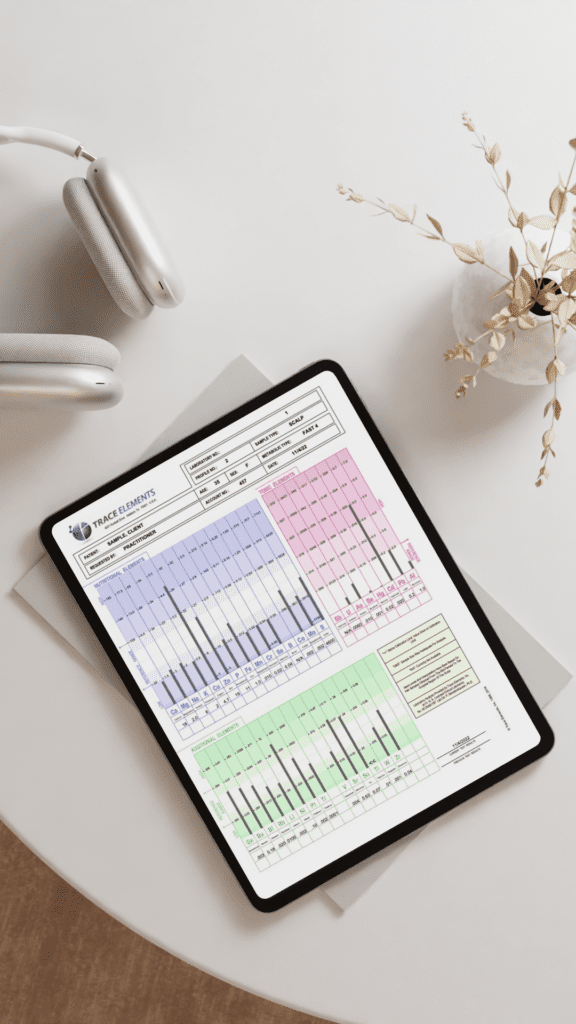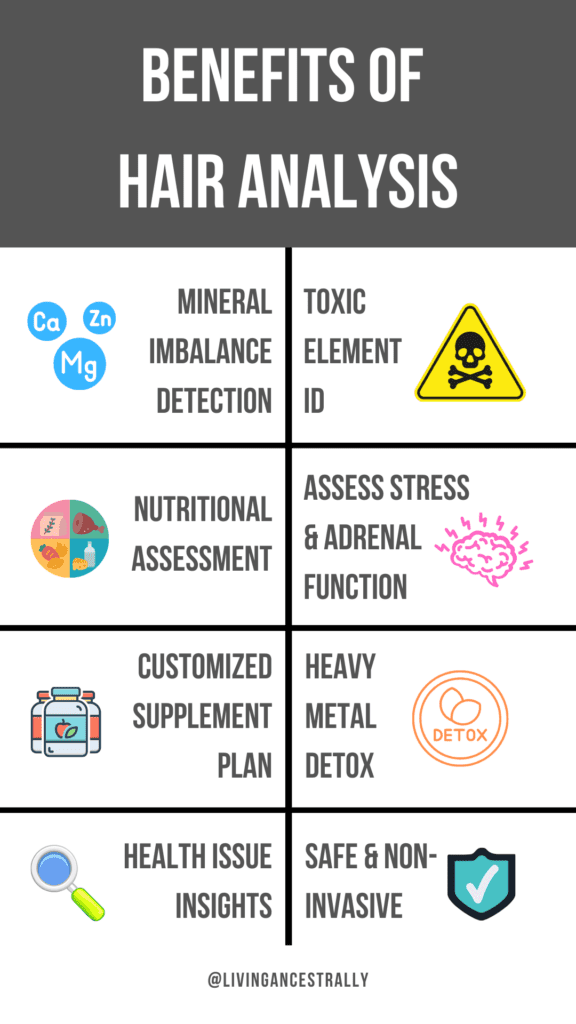Do you ever feel like something is off with your health, but can’t quite put your finger on what it is? Maybe you’re experiencing low energy, hair loss, low libido, skin issues, or any other symptoms that affect your day-to-day activities. The human body is complex and often gives us subtle signals that something isn’t right. But what if we told you that one of the most significant clues to your health could be right on top of your head – your hair?
Hair Tissue Mineral Analysis (HTMA) is a non-invasive test that helps decode the hidden messages our bodies send us. In this comprehensive guide, we’ll explain how hair analysis works and why more moms are including it as part of their preventive health routine. By the end, you’ll have a newfound appreciation for the power of your locks!

What is Hair Tissue Mineral Analysis (HTMA)?
The HTMA test is a simple way to measure the minerals in your body. It is not the same thing as a DNA test or DNA analysis.
To do the test, a small sample of your hair is taken, usually from the back of your neck.
This hair sample is sent to a lab that specializes in analyzing metabolic patterns, minerals, and harmful metals.
What Information Can Be Determined from a Hair Analysis?
The lab checks the levels of important minerals like calcium, magnesium, and potassium, as well as toxic metals like lead, mercury, and aluminum.
The results of the hair analysis give a detailed look at the balance of minerals in your body. The total number of minerals tested by the lab includes 35 different elements that are essential to optimal health.
Hair Mineral Analysis vs. a Blood Test
A hair analysis provides unique information about your body’s nutrition and biochemical state. It shows long-term information about the mineral concentration within each individual hair follicle.
Unlike blood tests that only capture a snapshot of your nutrient levels at one moment, HTMA reflects mineral levels over time.
A hair follicle acts like a storage tissue and records how your body uses minerals, which helps to identify imbalances in your mineral balance that might be causing health problems.
With that being said, testing blood chemistry can be helpful for checking certain minerals within the body. Starting with an HTMA test is very valuable for some people’s situations though.
Why Is It Important to Check My Mineral Levels?
Minerals are literally the spark plugs of life.
Our bodies cannot make hormones without minerals.
Our bodies cannot make enzymes without minerals which means that important enzyme reactions within the body don’t happen.
Vitamins don’t work properly without the proper balance of minerals.
Everything will be out of whack within the body if your minerals are imbalanced.
What Impact Do Toxic Metals Have on the Body?
As far as heavy metal toxicity goes, these metals can collect in your body over time through exposure to unfiltered water, air pollution, industrial waste, medications, food, and much more. This toxic metal accumulation shows up in your new hair growth that is analyzed in your hair samples.
Even newborn babies accumulate these harmful metals while in their mother’s wombs, as well as through breastfeeding. Sadly, moms unintentionally transfer heavy metals to their babies.
Our bodies were never meant to deal with the amount of heavy metals we are exposed to in our modern world.
As a hair analysis practitioner, I always encourage people to NOT jump into a heavy metal detox after they see their HTMA test results. That can be extremely harmful and painful. It’s very unnecessary. Feel free to reach out to me for guidance.
Read more HERE about the importance of hair mineral analysis for uncovering hidden toxicities like copper toxicity.
How Do You Collect a Hair Sample?

- Your hair analysis practitioner should provide a set of instructions that explain the hair testing process while also detailing proper hair preparation before the HTMA test. For instance, the hair sample should be free of hair dyes or other chemically-based hair treatments for up to 8 weeks before the hair samples are collected. Avoiding hair sprays and other hair products before collecting hair samples is also recommended.
- You will collect a hair sample from the hair closest to the scalp at the back of the head.
- The hair collected is sent to a laboratory where it undergoes a series of processes. There are several different labs that provide hair analysis. It’s important that your practitioner selects a lab that does not wash the hair before analyzing it. Trace Elements Inc. and Analytical Research are top-notch labs to choose from.
- This is followed by an analytic procedure using highly sensitive equipment to measure the concentrations of specific minerals within the hair samples.
- After your practitioner receives your test results, they should analyze them and provide you with a thorough assessment and appropriate recommendations.
What Can Hair Samples Show Us?
These measurements show the mineral content in our hair samples, indicating the body’s cell mineral status. This helps understand the body’s nutrition and metabolic trends over a longer period, unlike blood tests that reveal acute status.
Hair mineral analysis can detect patterns like a mineral deficiency or excess, indicating possible health problems before physical symptoms appear.
Why Are More Moms Turning to HTMA?
As moms, we always want to make sure our families stay healthy. But with so much conflicting health info out there, it can be hard to know what to believe.
HTMA is getting really popular because it gives us a clear idea of what’s happening inside our bodies. It helps us find imbalances and toxic metals before they cause more harm.
Moms: Here's Why YOU Need an HTMA
Mothers often face the challenge of mineral imbalance and nutritional deficiencies after having children.
During pregnancy, a woman’s body is working overtime to create life and nutrition for her baby. This means that essential minerals – such as calcium, magnesium, and potassium – can become depleted in the mother’s body as these minerals are passed to the baby.
After birth, breastfeeding can further deplete a mom’s mineral stores.
A hair analysis test can help moms gain insight into a potential mineral imbalance, how their minerals have changed after having children, as well as checking their heavy metal exposure.
This helps them identify potential imbalances and deficiencies, so they can take the necessary steps to restore their body’s mineral balance for optimal health.
Do I Need a Doctor's Note?
You don’t need a doctor’s note to get a hair mineral analysis test. All you need is an HTMA practitioner who can order one for you and mail the kit through the mail. You can collect your own hair sample, as well as your children’s at home.
Benefits of Hair Analysis for Uncovering Hidden Clues in Your Hair

How to Interpret Results from an HTMA Test?
Interpreting results from an HTMA test involves understanding the indicated mineral ratios and heavy metal analysis.
Each mineral on the hair testing report is related to certain bodily functions and conditions. For example, high levels of calcium may suggest a slow metabolic rate, while low levels can indicate a fast metabolic rate.
Ratios between different minerals also carry importance, as imbalances can indicate specific health issues. For instance, a high sodium-to-potassium ratio might suggest adrenal fatigue.
Seek A Qualified HTMA Professional
It’s essential to consult with a health professional knowledgeable in assessing hair analysis tests to accurately interpret such results, as the implications can vary depending on individual health profiles.
Relying on whole foods should always be the first priority, however, targeted supplementation of minerals may be necessary depending on the individual’s situation, as well as reducing exposure to toxic metals such as lead or mercury. A qualified HTMA practitioner should be able to guide you through this challenging process.
How Often Should I Recheck My Mineral Levels?
I generally recommend rechecking your levels with a hair analysis test with the same lab every three months while working to improve any mineral deficiencies or mineral excesses.
Some people’s hair grows relatively fast while other people’s hair grows slowly. In either case, three months is an adequate amount of time to see a difference in any dietary or supplement changes made after the first HTMA test. By consistently applying an informed approach to hair analysis tests, one can achieve mineral balance and start to feel better.
Unlock Your Best Health Yet With Hair Tissue Mineral Analysis
If you’ve tried everything else to improve your health or if you just want a preventative tool that can be used to monitor your nutrition and heavy metal status, then a hair mineral analysis might be the answer for your situation.
As you’ve learned, a hair tissue mineral analysis is a non-invasive, safe, and cost-effective way to decode the hidden messages our bodies send us. By analyzing levels of essential minerals and toxic metals, an HTMA test can help identify nutrient deficiencies, mineral imbalances, and toxic metal accumulation.
Whether you’re experiencing vague symptoms or want to be proactive about your health as well as the health of your family, consider including HTMA as part of your preventive health routine. Your locks may just hold the key to unlocking your best health yet!
References:
Tamari, G. (2005). The Importance of HairMineral Analysis. Anamol Laboratories Newsletter. pdf. Retrieved from http://www.anamol.com/2005%20Spring-English.pdf
Trace Elements. (n.d.). Hair Tissue Mineral Analysis (HTMA). Trace Elements. https://www.traceelements.com/EducationalResources/HTMA.aspx
Wilson, L. (2009). Explore Article. drlwilson.com. http://drlwilson.com/Articles/explore%20article.htm
Please note that A Hair Mineral Analysis (HTMA) is not intended to diagnose, treat, cure, reverse, or prevent any disease. It is not intended to replace any other medical test(s) that may be prescribed by your medical doctor.
